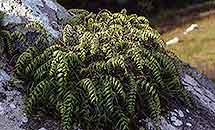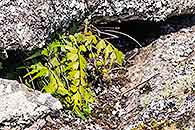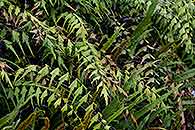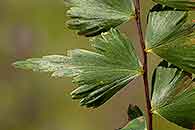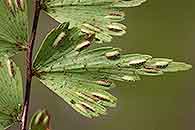Asplenium megalura Hieron.
Synonyms |
Asplenium molleri Hieron. |
|---|---|
Common name |
|
Description |
Rhizome erect or shortly creeping, to 5 mm diameter; rhizome scales dark brown, narrowly lanceolate, entire, up to 6 mm long with narrow pale brown borders, apex gradually tapering to a point and ending in hair-tip. Fronds tufted, rarely shortly spaced, arching, firmly membranous, not proliferous. Stipe shiny dark brown or greyish, up to 19 cm, glabrous except at the very base. Lamina up to 43 x 13 cm, 1-pinnate, narrowly oblong in outline, lowest pinnae not reduced, apical segment resembling others, often tricuspidate. Pinnae (sub-)opposite, subsessile, trapeziform in outline, 3-lobed, up to 9 x 4 cm, up to 11 pairs, base wedge-shaped, lower margin entire, apex abruptly ending in a very long tip, the distal margin and tip irregularly toothed, glabrous on both surfaces or with some scattered tiny lobed scales to 0.5 mm, veins flabellate, costa not clear. Rachis shiny dark brown, shallowly channelled ventrally, glabrous except for a few very small scales. Sori many per pinna, along veins, linear, (3–)5–20 mm long; indusium linear, membranous, entire, 0.4–0.5 mm wide. |
Notes | Differs from similar species by having pinnae with an apex that abruptly ends in a very long tip, this species is not proliferous. |
Derivation | |
Habitat | Literature states that this fern is found in wet forests, often near streams. In Malawi I found this species growing on rocky outcrops in montane grassland. |
Distribution worldwide | See African distribution. |
Distribution in Africa |
Burundi, Cameroon, Dem. Republic of Congo, Equatorial Guinea (incl. Bioko), Gabon, Ghana, Guinea, Ivory Coast, Kenya, Liberia, Malawi, Mozambique, Rwanda, Sierra Leone, Sudan and South Sudan, Tanzania , Togo, Uganda, Zambia. |
Growth form |
Epiphytic, lithophytic. |
Literature |
|
